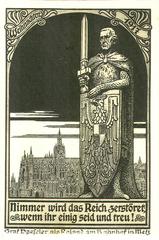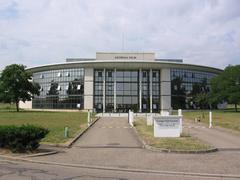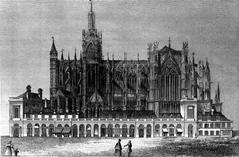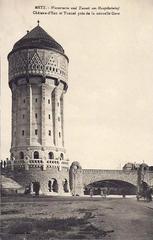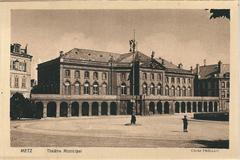
Basilica of Saint-Pierre-Aux-Nonnains Visiting Hours, Tickets, and a Comprehensive Guide to Metz’s Historic Landmark
Date: 04/07/2025
Introduction
The Basilica of Saint-Pierre-aux-Nonnains, located in the historic heart of Metz, France, is one of the oldest standing church buildings in the country. With origins dating back to the 4th century CE, this remarkable monument has evolved from a Roman gymnasium (palestre) to a Benedictine nunnery chapel and, today, serves as a prominent cultural venue. Visitors can explore nearly 1,700 years of history through its Roman masonry, Ottonian Romanesque expansions, and Gothic enhancements, all carefully preserved. Its layered architecture, significant role in the city’s religious and social life, and current use as a concert and exhibition venue make it an essential destination in Metz.
This guide provides detailed information on visiting hours, ticketing, accessibility, travel tips, and the basilica’s historical and cultural significance. Whether you are a history buff, architecture enthusiast, or cultural traveler, Saint-Pierre-aux-Nonnains offers an immersive journey through Metz’s rich heritage. For current visitor information and event schedules, consult the official Metz Tourism website, the Visit Grand Est portal, or cultural platforms like Spotting History.
Table of Contents
- Introduction
- Historical Overview
- Architectural Evolution: Styles and Features
- Cultural Significance and Historical Role
- Artistic and Liturgical Heritage
- Preservation and UNESCO Recognition
- Visiting Saint-Pierre-aux-Nonnains: Practical Information
- Community Engagement and Educational Role
- Visitor Experience and Recommended Duration
- Facilities and Amenities
- Safety and Security
- Best Times to Visit
- Local Legends and Insights
- Frequently Asked Questions (FAQ)
- Useful Links
- Visual Gallery
- References
Historical Overview
Roman Foundations and Early Christian Adaptation
Constructed in the late 4th century CE during the Roman Empire, the original building served as a palestre (gymnasium) and was possibly part of a larger thermal complex in the ancient city of Divodurum Mediomatricorum (Metz). Roman construction methods, such as thick opus mixtum masonry and stamped bricks, are still visible in the lower walls, providing insight into late antique architecture (sworld.it).
By the 7th century, the structure was converted into a Christian basilica for a Benedictine women’s abbey—hence the name “aux Nonnains” (of the nuns). Modifications included the addition of an apse and liturgical furnishings, adapting the Roman hall for Christian worship. This transformation marks the beginning of the basilica’s continuous sacred use.
Medieval Expansion and Gothic Developments
In the 10th and 11th centuries, the basilica was expanded in the Ottonian Romanesque style, with the addition of semi-circular apses, barrel vaults, and small, high-set windows characteristic of early medieval architecture. The nave, rebuilt during this period, reflects the transition to Romanesque design, while later Gothic modifications in the 15th and 16th centuries introduced pointed arches, ribbed vaults, and larger windows. The basilica also endured significant historical events, such as damage during the siege of Metz and its military conversion in the 16th century.
Modern Era: Restoration and Contemporary Use
After centuries of use as a warehouse and military barracks, the basilica was recognized as a monument historique in 1909. Restoration and archaeological work in the late 20th century preserved its Roman, Romanesque, and Gothic elements. Today, Saint-Pierre-aux-Nonnains is renowned for its acoustics and atmospheric setting, hosting concerts, exhibitions, and community gatherings (Metz Tourism).
Architectural Evolution: Styles and Features
- Roman Core: The original Roman walls, up to 1.5 meters thick, form the core of the nave. The basilica’s rectangular plan and robust masonry are hallmarks of late antique civic architecture.
- Romanesque Additions: Semi-circular apses, barrel vaults, and rounded arches from the 10th–11th centuries demonstrate early medieval engineering and design.
- Gothic Elements: Later modifications introduced ribbed vaults and larger windows, providing more light and a sense of verticality.
- Notable Features: The basilica’s minimal ornamentation, contrasting with later Gothic churches, draws attention to its monumental structure and the fusion of building techniques from different eras.
Cultural Significance and Historical Role
As a Benedictine abbey, the basilica played a central role in the religious, educational, and charitable life of medieval Metz. It was a center for liturgical innovation, notably under Bishop Chrodegang, who contributed to the development of the Metz chant, a precursor to Gregorian chant. The basilica also served as a burial site for notable locals and maintained close ties to the bishops of Metz. Secularization after the French Revolution led to its use for military and civic purposes, but its historical and cultural relevance endures.
Artistic and Liturgical Heritage
The interior of Saint-Pierre-aux-Nonnains is noted for its simplicity. While it lacks elaborate decoration, traces of early Christian and medieval art, such as wall paintings and carved capitals, have been found during excavations. The building’s acoustics make it a favored venue for choral and classical music, reinforcing its spiritual and artistic heritage.
Preservation and UNESCO Recognition
Significant conservation efforts since the 1970s have stabilized the basilica’s structure and improved accessibility, following principles of minimal intervention and respect for historical integrity. While not individually listed as a UNESCO World Heritage Site, the basilica is part of Metz’s historic center, which is recognized for its architectural layers spanning Roman, medieval, and modern eras (UNESCO tentative list).
Visiting Saint-Pierre-aux-Nonnains: Practical Information
Location
- Address: 1 Rue de la Citadelle, 57000 Metz, France
- GPS: Latitude 49.1124, Longitude 6.1724
- Nearby: Metz Cathedral, Centre Pompidou-Metz, Temple Neuf, Moselle River promenade (The Complete Pilgrim)
Visiting Hours
- The basilica is open primarily during scheduled cultural events (concerts, exhibitions, festivals).
- Typical Hours: Events usually take place in the afternoons or evenings; there is no regular daily opening.
- Check schedules: Always consult the official Metz tourism website or event platforms for the latest visiting hours.
Tickets and Admission
- General Admission: Free for most visits outside special events.
- Event Tickets: Required for concerts and exhibitions; prices vary (typically €19–€30 for concerts like Candlelight Series via Feverup).
- Booking: Tickets can be purchased online or at the venue during events.
Accessibility
- The basilica is accessible for visitors with reduced mobility, though some areas may have uneven floors due to the building’s age. Contact the Metz Tourist Office ahead for detailed information.
Facilities and Amenities
- As a historic site, facilities are limited; restrooms are generally available only during events.
- The surrounding city center offers a variety of restaurants, cafés, and shops.
Travel Tips
- Combine your visit with other historical sites in Metz for a complete experience.
- Arrive early for events to secure the best seating and enjoy the ambiance.
- Dress comfortably; the stone interiors can be cool year-round.
- Non-flash photography is permitted in most areas, but restrictions may apply during certain exhibitions or performances.
Community Engagement and Educational Role
The basilica serves as a living classroom for local schools and universities, offering workshops and guided visits that focus on its Roman, medieval, and musical heritage (Spotting History). These educational activities foster deeper community connections with Metz’s rich past.
Visitor Experience and Recommended Duration
Most visitors spend about two hours exploring the basilica, especially when attending an event or exhibition (TripHobo). The fusion of Roman, medieval, and modern elements provides a unique and atmospheric setting, enhanced by lighting during concerts.
Safety and Security
The site is well-maintained, with staff present during events to assist visitors. Standard safety precautions are advised, and visitors should follow staff instructions during performances.
Best Times to Visit
The basilica is especially atmospheric during evening concerts or candlelit events, when its ancient architecture is beautifully illuminated. The most extensive cultural programming occurs in spring and summer (Visit Grand Est).
Local Legends and Cultural Insights
Saint-Pierre-aux-Nonnains is associated with the legend of “La Nonne blanche de Saint-Pierre,” a mysterious nun who is said to have appeared as a warning spirit in medieval times. This folklore adds a mystical dimension to the basilica’s rich tapestry of history and is sometimes featured in special tours (Visit Grand Est).
Frequently Asked Questions (FAQ)
Q: When is the basilica open to the public?
A: The basilica is mainly open during scheduled events and exhibitions. Check the official Metz tourism website for current visiting hours.
Q: Is there an admission fee?
A: General visits are usually free; tickets are required for concerts and some exhibitions.
Q: Is the site accessible to visitors with reduced mobility?
A: Many areas are accessible, but contact the site in advance for specific details.
Q: Are guided tours available?
A: Guided tours are occasionally offered during events or heritage days. Check ahead for schedules.
Q: Can visitors take photographs?
A: Non-flash photography is generally permitted except during certain performances or exhibitions.
Useful Links
- Official Metz Tourism Website
- Visit Grand Est - Basilica of Saint-Pierre-aux-Nonnains
- Spotting History - Basilica of Saint-Pierre-aux-Nonnains
- Feverup - Candlelight Concerts
- Trek Zone - Basilica of Saint-Pierre-aux-Nonnains
- Sworld.it - Basilica History
- UNESCO Tentative List for Metz
- FranceRent - Basilica of Saint-Pierre-aux-Nonnains
Visual Gallery
- Exterior view of Basilica Saint-Pierre-aux-Nonnains, showcasing Romanesque façade (alt=“Exterior of Basilica Saint-Pierre-aux-Nonnains in Metz”)
- Interior nave with Gothic vaults in Saint-Pierre-aux-Nonnains (alt=“Interior nave with Gothic vaults in Saint-Pierre-aux-Nonnains”)
- Roman archaeological remains under Saint-Pierre-aux-Nonnains (alt=“Roman archaeological remains under Saint-Pierre-aux-Nonnains”)
Conclusion
The Basilica of Saint-Pierre-aux-Nonnains is a living testament to Metz’s rich historical and cultural legacy. Its Roman origins, medieval transformations, and vibrant present-day role as a cultural venue make it a must-see for anyone exploring Metz. With free general admission outside special events, accessible facilities, and a wealth of concerts and exhibitions, the basilica embodies the city’s spirit of adaptation and preservation. Enhance your experience with nearby attractions, and be sure to check updated hours and event information before your visit.
To enrich your exploration, download the Audiala app for guided tours and event updates, and follow local cultural platforms for the latest news. Connect with nearly two millennia of history in the heart of Metz at the Basilica of Saint-Pierre-aux-Nonnains.
References and Further Reading
- Official Metz Tourism Website
- Visit Grand Est - Basilica of Saint-Pierre-aux-Nonnains
- Spotting History - Basilica of Saint-Pierre-aux-Nonnains
- Sworld.it - The Basilica of Saint-Pierre-aux-Nonnains in Metz
- UNESCO Tentative List - Metz Historic Centre
- Feverup - Candlelight Concerts at Basilica Saint-Pierre-aux-Nonnains
- The Complete Pilgrim - Basilica Saint-Pierre-aux-Nonnains
- Trek Zone - Basilica of Saint-Pierre-aux-Nonnains
- FranceRent - Basilica of Saint-Pierre-aux-Nonnains



